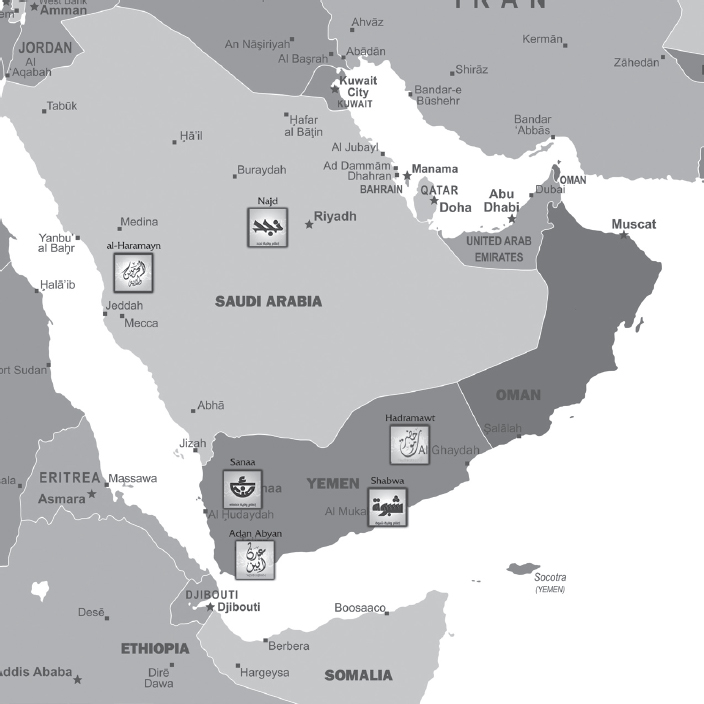
ISIS IN AFGHANISTAN, THE GULF STATES, ARABIAN PENINSULA, AND ASIA

ISIS IN AFGHANISTAN (KHORASAN)
HISTORY
In 2012, militants associated with ISIS started recruiting jihadists, primarily from the terrorist group Lashkar-e-Jhangvi Said, in Pakistan.609 In early 2014, ISIS began organizing and funding local groups in Afghanistan to compete with the Taliban and al-Qaeda.610 By September 2014, two hundred militants had left Pakistan to join the Islamic State. In October 2014, five regional Pakistani Taliban commanders (Hafiz Khan Saeed, Hafiz Quran Daulat, Gul Zaman, Mufti Hassan, and Khalid Mansoor) switched allegiances from Afghan Taliban leader Mullah Omar and pledged loyalty to Abu Bakr al-Baghdadi.611 Additional leaders pledged allegiance in a January 10, 2015 video, including Saad Emirati of Logar Province, Ubaidah al-Peshwari of al-Tawhid in Peshawar, Shekh Muhsin of Kunar province, Talha of Lakki Marwat, and Omar al-Malnsur of the Lal Masjid (Red Mosque). The group calls itself the Islamic State of Khorasan, comprising Afghanistan, Pakistan, and parts of India.
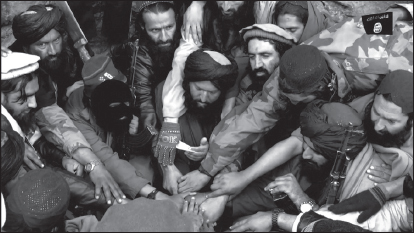
Afghanistan ISIS members swear a Bayat, or loyalty oath, to Abu Bakr al-Baghdadi.
ISIS has sympathizers or open supporters in twenty-five of Afghanistan’s thirty-four provinces. Much of the recruitment occurs due to ISIS’s large bankroll and social media. ISIS fighters combat the Afghan army on a regular basis, but do not generally fight other militant Islamic groups, with one exception: for control of the drug trade in Nangarhar Province.612 Although the Khorasan province cells may recruit small militant groups in the area as well as Taliban splinter groups, its competitor, the Taliban, is well entrenched and has experience dealing with such groups. Unless and until the Khorasan group is able to attract enough followers, they are unlikely to engage or prevail against the Afghan Taliban. However, many Pakistani militants have been impressed by ISIS’s successes in Syria and Iraq.613 Another competitor for hearts and minds in the region is al-Qaeda of the Indian Subcontinent (AQIS); analysts speculate that this and other groups will conduct terror operations and atrocities to demonstrate a competitive effectiveness over ISIS.614
Khorasan operatives freely distribute pamphlets in the markets of large Pakistani cities such as Peshawar.615 Little is known about ISIS’s military coordination efforts with Afghan militants, or the Khorasan group’s capabilities, but it is clear that they have routed the Taliban out of sections of Nangarhar province.616 In turn, as of September 2015 the intelligence on ISIS in that province, which may be coming from the Taliban itself, has become so well developed that well over a hundred members were killed by Afghan Special Forces and airstrikes on their camps in less than sixty days.
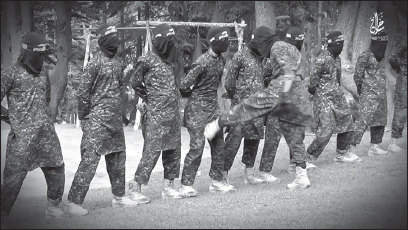
ISIS recruits test their stamina in a terrorist training camp in Nangarhar province, Afghanistan.
AFGHANISTAN MILITANTS PLEDGE LOYALTY TO ISIS
“I show allegiance to the commander of faithful, Caliph Abu Bakr al-Baghdadi Qureshi al Hussaini, and will listen and obey every order of you and follow your orders regardless of what circumstances may be.”—Shahidullah Shahid, (January 2015)
ORGANIZATION OF ISIS IN AFGHANISTAN/KHORASAN
ISIS-Khorasan’s control on the region is tenuous, and they have not announced a formal organizational structure. However, leaders of regional groups could be said to be “Emirs” of certain provinces, even if they have only a handful of followers, and do not control those provinces outright.
National Level
Emir: Hafiz Saeed Khan (reported killed July 10, 2015, status uknown)
Deputy: Abdul Raul Aliza (killed February 9, 2015)
Deputy: Hafiz Wahidi (killed March 18, 2015)

Regions
Kurram Agency
Emir: Hafiz Quran Daulat
Khyber Agency
Emir: Gul Zaman (died July 7, 2015)
Affiliated tribe: Qambar Khel tribe
Peshawar
Emir: Mufti Hassan
Affiliate: Ubaidah al-Peshwari, leader of the al-Tawhid and Jihad Group in Peshawar
Hangu District
Emir: Khalid Mansoor
Kunar Province
Emir: Qari Harun
Affiliate: Sheikh Muhsin
Logar Province
Emir: Saad Emirati
Lakki Marwat Province
Emir: Talha
Hudhayfah group
Other Affiliated Groups
Direct Support
Tehrik-i-Taliban Pakistan (TTP) (Spokesperson: Shahidullah Shahid)617
Ansar-ul-Khilafat Wal-Jihad
Pakistani Jundullah
Lal Masjid
Jamia Hafsa
Indirect Support
Jamat-ul-Ahrar618 (Spokesperson: Ehsanullah Ehsan)
Lashkar-e-Jhangvisaid619
Ahl-e-Summat Wai Jamat
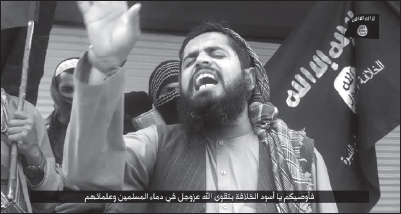
ISIS member in Afghanistan spreads the message of the cult of jihad.
PROPAGANDA
The Khorasan group regularly distributes multiple-language recruitment pamphlets in large Pakistani cities. They are also stepping up the number of English-language communications, indicating an increasing degree of sophistication. They have also released videos depicting pledges of allegiance, which included the beheading of a Pakistani called “Manzoor,”620 as well as a video showing the execution of four Afghan prisoners by blowing them up with land mines.
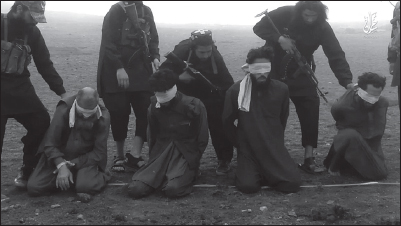
ISIS Khorasan blows up group of Shiite Muslims for being “apostates.” They placed explosives under each victim and fired it off with a linear detonation cord.
The Islamic State of Khorasan has an ongoing recruitment campaign throughout the region, consisting of word-of-mouth, pamphleteering, and bribery of top commanders.
Khorasan group militants regularly conduct isolated bombings and ambushes, but not in a coordinated campaign.
In September 2015, the Khorasan group also conducted a successful military campaign against the Afghan Taliban in the Achin, Dih Bala, and Nazyan districts of Nangarhar Province. They conducted operations against Afghan security forces in this area for the first time. The area provides access to agricultural drug products, as well as the smuggling routes of the border area to Pakistan.
WEAPONS AND EQUIPMENT ORDER OF BATTLE
Little is known of ISIS’s arsenal or capabilities in Afghanistan. However, as ISIS’s Khorasan group consists mainly of former Taliban splinter groups, the equipment and training of Khorasan militants would likely resemble that of what has generally been associated with traditional Taliban fighters, including light arms, machine guns, RPGs, IEDs. Although anecdotal, an Afghan militant in Peshawar estimated that ISIS training “is much more advanced than ours and it’s good for us to learn those techniques.”621
FINANCE
Khorasan leadership has cultivated tentative ties to local Islamic militant groups through bribes, presumably from ISIS coffers. The Khorasan group’s fight against Taliban leaders in Nangarhar Province appears to be an attempt to control the revenue from the drug trade in those areas.
2012
Militants later associated with the nascent group that would be called ISIS begin recruiting followers in Pakistan.
November 2012
Dozens of Pakistani fighters from Lashkar-e-Jhangvisaid embark for Syria to fight Bashar al-Assad.
September 2014
A dozen militants cross the border to Pakistan to deliver pamphlets in Pashto, Dari, and Farsi, calling on obedience to the Caliph of the Islamic State and jihad against the United States in Muslim lands.
October 2014
Taliban leader Abdul Rauf Khadem, a former adviser to Mullah Omar, visits Iraq.
January 10, 2015
Islamic State formally declares establishment of the Islamic State of Khorasan, with Hafiz Khan Saeed, a former Tehrik-i-Taliban commander in Orakzai, Pakistan.622
May 2015
ISIS Khorasan claims responsibility for a terror attack in Karachi, Pakistan, when six gunmen on motorcycles stop a bus, killing forty-five passengers with small arms fire.623
July 10, 2015
US DOD reports that Emir of Khorasan Hafiz Saeed Khan is killed by drone strike in Eastern Afghanistan. Three days later an audio recording indicates that he is still alive.
August–September 2015
ISIS pushes the Taliban out of Achin, Dih Bala, and Nazyan districts of Nangarhar Province, which are on or near the border of Pakistan.624
ISIS gunmen attack checkpoints in the Achin District of Nangarhar Province, killing nine policemen and wounding another eight. Afghan forces retaliate with attacks by air, killing eighty-five ISIS fighters, all of whom were Pakistani, according to Afghan National Directorate of Security statement.
September 29, 2015
US Treasury Department sanctions Hafiz Saeed Khan, despite reports of his death on July 10, 2015 by US Department of Defense.
November 6, 2015
Afghan Special Forces kill thirty-two ISIS members in the hillsides of Achin in Nangarhar province.625
November 20, 2015
Afghan forces kill twelve ISIS terrorists in Nangarhar province.626
December 6, 2015
Thirty-nine ISIS-Khorasan members were killed in combined air-to-ground combat missions by Afghanistan Special Forces and Air Force missions. Six ISIS were killed in Achin district by airstrikes. Thirty-three others were killed in a counterterror operation against their basecamp in Nangarhar Province. An ISIS radio communications network was also destroyed.627
ISIS IN SAUDI ARABIA
HISTORY
It has been estimated that 2,500 Saudis have recently traveled to Iraq and Syria to join the conflict there.628 The country was seen as the largest source of foreign suicide bombers during the Iraq war.629 At the same time, however, Saudi leaders have worked closely with American officials to successfully thwart terrorist plots and have been commended for de-radicalization efforts directed toward former terrorists.630
FIRST SIGNS OF THE ISLAMIC STATE IN SAUDI ARABIA
The fact that both Mecca and Medina lie within Saudi Arabia, and Abu Bakr al-Baghdadi’s belief that the king of Saudi Arabia and his family are not legitimate custodians of Islam, are key reasons why ISIS, following in the footsteps of al-Qaeda, has targeted the leadership and the nation for destabilization.631 In November 2014, Abu Bakr al-Baghdadi delivered a speech exhorting ISIS supporters to turn on Saudi leaders:632
O sons of al-Haramayn [The two Holy shrines of Mecca and Medina]… the serpent’s head and the stronghold of the disease are there… draw your swords and divorce life, because there should be no security for the Saloul.633
“Saloul” is a disparaging term used by the cultists to insult the Saudi leadership. In the same speech, al-Baghdadi also claimed to have accepted pledges of allegiance from supporters in Saudi Arabia and several other countries in the region.634
At the same time, Saudi Arabia’s Interior Ministry noted a shift in ISIS online recruitment toward potential jihadists within the Kingdom to carrying out attacks in place rather than traveling to ISIS territory.635 All of this was an indication that a Saudi-Takfiri civil war was gestating.
On April 28, 2015, Saudi officials announced that between then and the prior December, ninety-three people had been arrested on suspicion of links to ISIS.636 By July, officials announced an additional 431 had been arrested.637 Toby Matthiesen, a senior research fellow at Oxford University, is an expert on Saudi Arabia. He was quoted saying to the Guardian:
Saudi Arabia may now have to choose between anti-Shia [sentiment] as a political tool at home and abroad and the very real threat that extremists taking anti-Shia [sentiment] too seriously will bring the fight back home—with unpredictable consequences for the stability of Saudi Arabia and the wider region.
On November 10, 2014, a group called Mujahideen of the Arabian Peninsula pledged allegiance to Baghdadi.638
It also appears that a number of unnamed, purportedly Saudi individuals have been posting images of written pledges of allegiance, including a cake in the shape of the ISIS flag.639
ORGANIZATION OF ISIS IN SAUDI ARABIA
There appear to be three wilayat proclaimed in Saudi Arabia: Haramayn, Najd, and Hijaz. According to the Soufan Group, ISIS’s presence inside Saudi Arabia could be characterized as “meaningful and operational.”640 The identities of senior leadership are not publicly known at this time.

CAMPAIGNS
In November 2014, eight Saudis were shot to death in Al-Ahsa in one incident,641 while a Danish citizen was killed in Riyadh.642
January 5, 2015
Two SPBIEDs killed two Saudi border guards and injured their commanding officer in Arar. Guards killed one of the two attackers but the second one detonated his vest when captured.643
April 18, 2015
Yazeed Mohammed Abdulrahman Abu Nayyan—aided by accomplice Nawaf bin Sarif Samir al-Enezi—opened fire on two police officers in Riyadh, killing both.644
Late May 2015
Two suicide bombers struck in the same week at mosques in Dammam645 and al-Qadeeh646 killing four people in the former and 21 at the latter.647 Unlike previous “lone wolf” attacks, these attacks suggested coordination.648
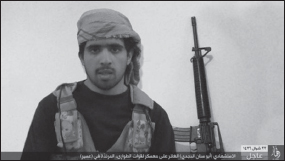
Abu Sinan al-Najdi martyrdom attacker on Saudi Special Emergency Forces Center in Asir killing 15
A new group calling themselves Hijaz Province of the Islamic State took responsibility for a mosque bombing in Abha, Saudi Arabia, targeting Saudi security forces.649
October 16, 2015
After a gunman attack that killed five, ISIS’s claim of responsibility came via a branch named “Bahrain Province.” The attack was carried out via a stolen taxi. One ISIS fighter was killed; the remaining two were arrested.650
FINANCE
In late 2010, the Guardian published a leaked cable in which Secretary of State Hillary Clinton wrote: “[D]onors in Saudi Arabia constitute the most significant source of funding to Sunni terrorist groups worldwide.”651
Saudi officials have identified schemes by which ISIS solicits donations via Twitter and accesses them via Skype,652 in which donors relay the numbers of international pre-paid cards to organization representatives.653
The images of Saudi individuals pledging support online serves evidence of a key source of funding.654
ISIS IN YEMEN
HISTORY
Background
Yemen is the poorest country in the Middle East.655 It has longstanding divisions. From 1970 to 1990, southern Yemen was independent.656 In 1994, a short civil war erupted.657 In 2012 President Ali Abdullah Saleh, who had held power for thirty years, was toppled in an election during the Arab Spring.658 His vice president, Abdu Rabbu Mansour Hadi, was voted in, the only candidate on the ballot.659 This orderly succession was seen at the time as a “model for post-revolutionary Arab states.”660
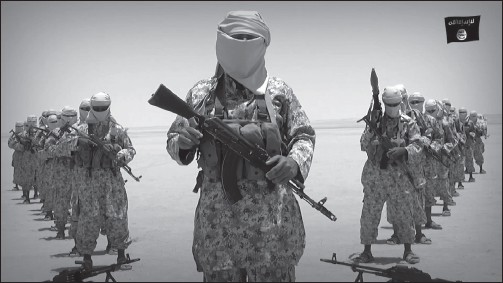
Terrorists in Yemen declare pledge loyalty oath to ISIS.
The Iranian-backed, Shi’ite Houthi tribes allied with Saleh661. They descended on Sana’a, Yemen’s capital, in September 2014, a move that culminated in an assault on the presidential palace in January 2015 and the subsequent ouster of Hadi, who left Yemen entirely on March 25, 2015.662 The Houthis are Zaydi Shi’ites and staunch opponents of al-Qaeda, and are viewed by Saudi Arabia to be so closely allied with Iran as to be an extension of Tehran.663
In the wake of Hadi’s ouster, the country fell into a complex civil war664 with eight factions. Saudi Arabia implemented a full-scale military intervention of Yemen called Operation Decisive Storm. Using GCC troops from Saudi Arabia, Qatar, Kuwait, the United Arab Emirates, Egypt, Morocco, Jordan and Bahrain they imposed a naval blockade and started air strikes in March 2015. The Saudi Army led a small footprint ground campaign to support the Hadi forces that has since enmeshed itself in a deep insurgency with the Houthis and exposed itself to terrorist attacks by both al-Qaeda and ISIS. Al-Qaeda in the Arabian Peninsula (AQAP), Al Qaeda’s strongest branch,665 comprised of Saudi and Yemini offshoots that consolidated in 2009,666 used the confusion as an opportunity for a territorial grab.667 Saudi involvement in Yemen’s civil war helped ISIS gain traction.668
First Signs of the Islamic State in Yemen
In March 2015, ISIS affiliates claimed responsibility for the capture and execution of twenty-nine Yemeni soldiers, just days after ISIS had claimed responsibility for two mosque bombings that killed 137 Houthis. The mosque bombings represented the first indication that ISIS was massing sizable forces in Yemen669 and represented the deadliest terrorist attack in Yemeni history.670
This was followed up in July with unverified images purportedly showing an ISIS training camp established in Aden, a seaside city in southern Yemen.671
If ISIS continues to grow in Yemen, it will be headed toward a direct confrontation with AQAP, a development which fundamentally threatens al-Qaeda overall.672 Thus far, the two groups have not engaged in direct battle in Yemen,673 and for the moment, it seems unlikely that they will any time soon.674
Yemen Pledges Loyalty to ISIS
In early February, a band of fighters supporting AQAP apparently transferred their loyalty to ISIS.675 Their announcement wasn’t verified:676 “It is unclear how credible those reports are and whether they come from a faction of AQAP that would have any significance,” according to a US State Department spokesperson.677
However, there is reason to believe that some AQAP leaders have indeed jumped ship—such as Maamoun Hatem, whose May 11 death via drone strike prompted ISIS members to eulogize him on Twitter.678
In an April 24, 2015 video, twelve masked men identifying themselves as “Soldiers of the Caliphate in Yemen”679 pledged allegiance to the caliphate.680
ORGANIZATION OF ISIS IN YEMEN
It is thought that seven sub-wilayats fall under Wilayat al-Yemen:
1. Sana’a
2. Ibb and Taiz (the “Green Brigade”)
4. Aden
5. Shabwa
6. Hadramawt
7. al-Bayda681
LEADERSHIP

The head of ISIS in Yemen is reportedly the Saudi Nasser al-Ghaydani, whose nom de guerre is Abu Bilal al-Harbi.682
OTHER SIGNIFICANT EVENTS
March 20, 2015
Two mosques are bombed by four suicide bombers in Sana’a, allegedly wearing explosive vests, killing 137. The first bomber at the al-Badr mosque detonated outside the gate when confronted by guards. The second bomber then detonated as the worshipers fled. The next two attacked at the al-Hashoosh mosque. This would be the largest attack in Yemen by ISIS.683
April 2015
ISIS executes fifteen Yemeni soldiers, four of whom are beheaded.684
April 23, 2015
The “Green Brigade” claims responsibility for an attack on Houthi in Yarim. No information on the group accompanies their message.685 Seven ISIS attacks on religious sites in June 2015 kill approximately one hundred Houthi supporters. 686,687
June 17, 2015
Four car bombs target the Houthi headquarters in Sana’a. Of the four car bombs, two were suicide attacks.
ISIS claims responsibility for four additional attacks on Houthi sites (killing approximately thirty) and two car bombs, one set off near a mosque and the other in a Houthi-secured area in Sana’a.688
Aug 20, 2015
ISIS claims attack on government building, which was targeted against the governor in Aden.689
August 23, 2015
ISIS loads several Houthi prisoners onto a boat on the port of Aden and detonates it.690 Video later released via Wilayat Aden.
September 2, 2015
Al-Muayad Mosque bombing kills at least twenty in the al-Jeraf area of Sana’a.691
September 24, 2015
Yemen mosque attack in Sana’a kills twenty-five at the al-Balili mosque.692

ISIS Land cruiser ‘technical’ moves through the war torn streets in Yemen.
October 2015
ISIS conduct a number of bombings in Aden and Sana’a.693 Targets include a hotel where government officials are staying, the headquarters used by soldiers of the nine-member Saudi-led694 Persian Gulf coalition fighting against the Houthi rebels to restore Hadi to power, and a mosque.695 The attacks use two SVBIEDs and rockets, with car bombs at the al-Qasr Hotel.
WEAPONS AND EQUIPMENT ORDER OF BATTLE
Immediately after the Houthi takeover of Sana’a and Hadi’s ouster, the US military acknowledged that it has ceased being able to account for a large stash of equipment sent over to Yemen over a period of years.696 According to the Guardian, this equipment includes “helicopters, night-vision gear, surveillance equipment, military radios, and transport aircraft.”697 It was believed at the time that Houthi rebels had taken control of the equipment, which totaled more than $500 million. “We have to assume it’s completely compromised and gone,” an anonymous legislative aide told the Washington Post. US officials maintained that the lost equipment would not meaningfully impact the conflict; guns and heavy weaponry have been and continue to be easily obtainable in Yemen.698
ISIS FORCES DEFECT IN YEMEN DUE TO ABUSES
Translation provided by the US Directorate of National Intelligence Open Source Center.699
… We, the soldiers of the Islamic State in Yemen, the undersigned, do hereby declare our pledge to the caliph of the Muslims, Ibrahim Ibn-’Awad al-Hussayni al-Qurayshi [refers to ISIL leader Abu-Bakr al-Baghdadi], and once again renew our pledge to the caliph in all matters, except in those matters in which we observe clear apostasy. We will state the truth and fear only God.
There are excesses and violations against sharia currently taking place in Yemen by the wali and his inner circle. Despite our efforts to advise and inform the caliph’s office on matters happening in Yemen, the violations against the sharia remain present and continue to increase. They stopped working in accordance with the prophetic path regarding the resolution of many problems and issues. Most recently, the following took place:
First: The dismissal of a number of soldiers of the Islamic State after they filed a lawsuit against the military commander on the pretext that there is no need for them now, knowing very well that some of them are fugitives wanted by the enemy.
Second: The death of many Islamic State soldiers during the “Sir and Shibam” incident in Wilayah Hadramawt due to the lack of basic resources for the battle, including:
• Lack of a plan of retreat
• Lack of support detachments for the fighters
• Lack of scouts and guides with knowledge of the area
• Lack of a medical team and supplies
• The adjustment of the battle plan hours before zero hour to attack two barracks instead of one
• The prevention of some of the fighters from gaining access to necessary weapons for the battle by the military commander
… and many others.
This led to the loss of many more brothers on the roads and the killing of almost half of the soldiers participating in the battle. The martyrs’ corpses were not retrieved for a period of two days so that they might be buried among the Muslims. Despite all this, no official measure was taken to hold the military official to account.
Third: The wali of the coast, Abu-Muhammad al-Najdi [from the Najd region of Saudi Arabia], refused to accept the arbitration of a sharia court in the matter of the Al-Tawasul tribe. This had been the demand of the relatives of the slain in order to prove the apostasy of their sons [as received]. Despite this, the wali informed them that he refused this arbitration without any consequences. Sharia officials wrote to the wali more than once but he never responded to them.
• Oppressing the downtrodden
• Expelling the muhajirin [refers to foreign fighters]
• Segregating most of the Ansar [refers to local fighters] who harbored and took care of [members of] the [Islamic] State, even when the State lost most of the land that had sheltered it.
These [things] have caused us to adopt the following stance and profess before God the Exalted and Sublime the following:
Removing the Wali of Yemen and his retinue, stating as Ibadah, may God be pleased with him, said: “By God, I do not accompany him in his soldiers a black night.”
*Warning: Do not disseminate the statement to anyone other than to the soldiers of the Islamic State.
ISIS IN OTHER GULF STATES
Other Gulf States are members of the Gulf Cooperation Council,700 consisting of Kuwait, the United Arab Emirates, Oman, Qatar, and Bahrain. The GCC is a mutual defense organization that came into being in 1981 in the shadow of the Iranian revolution and the Iran-Iraq war.701

Abu Sulayman al-Muwahid suicide bomber at Kuwaiti mosque.
FIRST SIGNS OF THE ISLAMIC STATE IN THE GULF REGION
On June 26, 2015, ISIS conducted a suicide bombing attack at the Imam Ja’far as-Sadiq Shi’a mosque, killing twenty-seven and wounding 227.
On the heels of the suicide bombing of a Kuwaiti mosque, ISIS announced it would be targeting Bahrain next.702 Turki al-Binali, the Bahraini-born ISIS commander who went to Syria in 2014, made the announcement.703
On October 22, 2015, Bahraini officials announced they had arrested twenty-four people for links to ISIS, including the charge that they were trying to set up a terrorist cell.704
ISIS IN BANGLADESH
HISTORY
Despite Bangladesh’s large Muslim population (146 million) and decades-long history of militant Islamic groups,705 706 ISIS activity in Bangladesh has been surprisingly limited until recently. Westerners with Bangladeshi backgrounds and ties to ISIS are sometimes arrested, but infrequently, and Bangladesh police have caught a handful of young ISIS-affiliated militants, usually while in transit to or from Bangladesh. Little is known about the leadership, structure, distribution, or capabilities of the self-titled “Caliphate in Bangladesh.”
According to reports, US officials have warned Bangladesh authorities of evidence that ISIS is beginning to organize and become operative. Despite this, the Prime Minister of Bangladesh refutes ISIS’s disruptive capabilities. Currently, the Caliphate in Bangladesh has not conducted any coordinated campaigns, preferring instead to conduct small hit-and-run attacks on police checkpoints, killings of foreign nationals, and isolated attempts to kill large numbers of the Shi’a minority on buses and in mosques. These attacks have grown in number and in casualties during late 2015, and may be an indication of growing sophistication, organization, and determination of the Caliphate in Bangladesh.
ASSASSINATION OF ITALIAN AID WORKER
Cesare Tavella, fifty, an Italian national working as a veterinarian for the Dutch church cooperative ICCO, arrived in Bangladesh in late August 2015 to work as a program manager on a rural food security and economic development project.707 On September 28, 2015, three assailants on a single motorcycle approached him in the high-security Gulshan market diplomatic zone of Dhaka while he was jogging.708 Two of the assailants shot him dead while one waited with the motorcycle. Witnesses heard at least three gunshots. The assailants got on the motorcycle and left immediately without taking anything from Tavella. Doctors declared Tavella dead after transport to a local hospital. Dhaka’s Metropolitan Police Commissioner Asaduzzaman Mia speculated that the murder was planned in advance.
A day later, ISIS claimed responsibility for the attack in a statement saying that a security detachment had tracked Tavella and killed him with “silenced weapons,” and that “citizens of the crusader coalition” in Muslim nations would receive similar treatment. It was the first time ISIS had claimed responsibility for a terrorist operation in Bangladesh.
On October 26, 2015, police authorities announced the arrest of four men for the assassination attempt. In a press briefing, Commissioner Mia said that three of the assassins were ordered to kill a Caucasian foreigner, but did not specify who gave the order. The fourth man provided the motorcycle. Although the political and religious affiliations of the men are unknown, Commissioner Mia cited “technology and other means, that the publicity was made saying IS did it was not authentic,” and suggested that ISIS was protecting “the real culprits,” whom he suggested were political opponents of Prime Minister Sheikh Hasina.
August 7, 2014
Five militants pledge allegiance in video.709
September 7, 2014
Bangladesh police catch Indian youths entering Bangladesh to join ISIS.710
July 2, 2015
Bangladesh police catch twelve men with ties to al-Qaeda.711
October 2015
US officials tell Bangladeshi counterparts there are indications that the IS will intensify efforts within Bangladesh. Italian aid worker killed in Dhakar diplomatic zone. Japanese agricultural advisor shot in Northern Bangladesh.712
October 24, 2015
ISIS operatives throw three IEDs at Huseiniyat Dalan, a Shi’a mosque in Dhaka, killing one and injuring eighty.713 714
October 28, 2015
Bangladesh PM Sheikh Hasina rejects reports of ISIS involvement in recent attacks: “Bangladesh is moving ahead and it’ll do so… Let me say one thing: The march forward of Bangladesh can’t be stopped by hurling two bombs or five eggs. Those who are thinking this are making a mistake.”715
November 4, 2015
ISIS operatives on motorcycles ambush a police checkpoint in Baruipara, near Dhaka. The assailants stabbed and shot two police officers, then fled the scene.716
November 19, 2015
ISIS operatives shoot and critically wound Italian missionary Piero Parolari in Dinajpur province, 277 km (172 miles) northwest of Dakha.717
November 26, 2015
ISIS claims responsibility for an attack on worshippers at a Shi’ite mosque in Shibganj, northern Bangladesh, 125 km (78 miles) from Dhaka.718